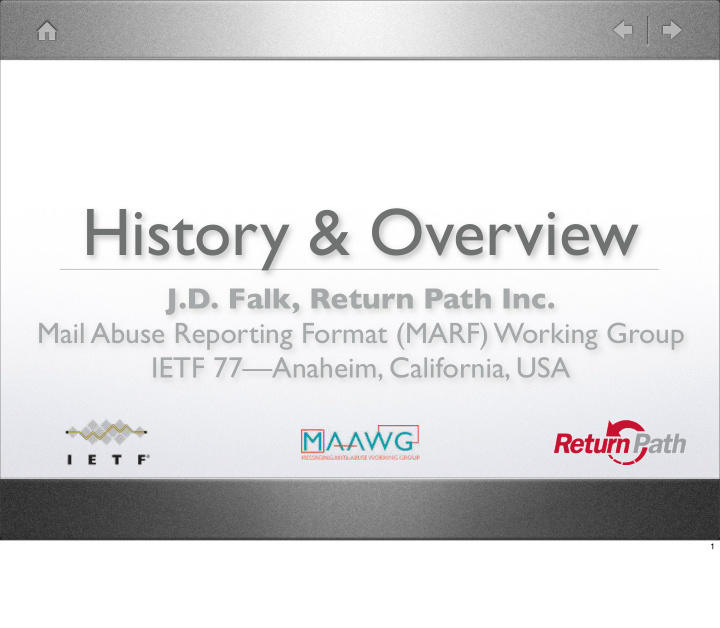



History & Overview J.D. Falk, Return Path Inc. Mail Abuse Reporting Format (MARF) Working Group IETF 77—Anaheim, California, USA 1
• Complaint Feedback Loops • Rationale • History • ARF ➠ MARF • History • Installed Base • Format Overview 2
Complaint Feedback Loops 3
end users receive spam 4
they want to complain 5
complaint mechanism • users click a “spam” button in their mail client (MUA) • the message is returned to their mailbox provider via an out-of-scope process • the mailbox provider collects complaints, and processes them using their own out-of- scope logic 6 usually to improve their spam filters but spam filters don’t address the root cause, the source of the problem
let’s share! 7 so a few mailbox providers started forwarding complaints to each other
FBL Subscriber Database FBL subscriber Complaint FBL ARF Report Spam SMTP SMTP processes Processor Processor message message, USER takes action subscriber Spam Filter Rules 8
Complaint Feedback Loop • generators • consumers • mailbox providers • hosting companies • a 3rd party working • ESPs on behalf of the • direct senders mailbox provider (author or operator) • a 3rd party working on behalf of the author or operator • researchers 9
Approve John Q. Example abuse@example.com fbl@example.com FBL ISP 192.168.50.1 192.168.50.2 Subscriber 192.168.99.12 subscriber Database Confirm abuse@ 10 in nearly every case, the feedback flows from generator to consumer, or subscriber, by prior arrangement: the consumer requests feedback, and the generator decides whether to approve that request. in this example, the consumer’s abuse@ address is asked to confirm that this particular applicant is appropriately asking on behalf of that domain — a fairly common practice. however, the approval process is out of scope.
What You Got • one new SMTP message per complaint (just like forwarding) • headers & body dumped into body portion of a new message (forwarding inline) • various encoding • various whitespace • sometimes explanatory text at the top 11 sometimes message/rfc822
ARF 12
ARF Timeline • “spam” button appeared around 1998 • abuse reporting group formed in 2005 • spinoff from MAAWG, plus a few experts • initially a closed discussion • feedback-report-00 — March 2005 13 general recollection is that AOL had the button first, and later it became standard in webmail clients; there was also Vipul’s Razor, a collaborative spam reporting system which became part of Cloudmark, who distribute a plugin for desktop MUAs
ARF Timeline • larger, open discussion started • first implementations began to appear • feedback-report-02 — May 2007 • already the de facto standard 14 we weren’t working very fast anymore, because a de facto standard was su ffj cient
ARF Timeline • feedback-report-04 — March 2008 • added DKIM failure reporting • feedback-report-08 — October 2009 • last non-IETF version 15
M ARF Timeline • draft-ietf-marf-base — January 2010 • removed all report types not currently in use (they can come back as extensions) • 1st MARF WG meeting 16
Installed Base: ARF Generators • AOL • RackSpace • BlueTie • Outblaze • Comcast • Road Runner • Cox • Tucows • Earthlink • USA.net • Microsoft • Yahoo! 17 (12 biggest ARF generators by volume, in alphabetical order) just over half of these are operated by a 3rd party, and thus are on the same codebase I know of about a dozen more implementations in progress
Known Outliers • ARF reports generated by an MUA • ARF reports sent to role accounts such as abuse@ without prior arrangement (not recommended unless you are John Levine) • ARF reports generated from spamtrap messages, rather than complaints 18 these aren’t necessarily out of scope, but they aren’t the primary use case
MARF 19
draft-ietf-marf-base • defines a new MIME type: message/feedback-report • Determination of where these reports should be sent, how trust among report generators and report recipients is established, and reports related to more than one message are outside the scope of this document. 20
Stated Requirements • both human and machine readable • entire original email message enclosed • machine-readable meta-data • must be extensible 21
Unstated Requirements • Must remain compatible with current installed base of generators & consumers • Intended for software-to-software and software-to-human communication, rather than human-to-software or human-to-human • Redaction (removing part of a message due to privacy concerns) is going to happen 22 thus, while primarily machine-readable, it should also be at least as human-readable as standard email headers
MIME parts • multipart/report report-type: feedback-report • text/plain • message/feedback-report • message/rfc822 or message/rfc822-headers 23
text/plain portion • an entirely human-readable section, often containing canned boilerplate 24
message/feedback-report • various header-like fields contain metadata • Note that these fields represent information that the receiver report generator is asserting about the report in question, but are not necessarily verifiable. Report receivers MUST NOT assume that these assertions are always accurate. 25
message/feedback-report required fields • Feedback-Type: • User-Agent: • information only; • abuse no registry • fraud • Version: 0.1 • other • virus 26 there used to be other feedback-types, but they weren’t used I believe the DKIM failure report type will be reintroduced as an extension, not aware of anyone intending to reintroduce the others
message/feedback-report optional fields appearing once appearing multiply • Original-Envelope-ID: • Authentication-Results: • Original-Mail-From: • Original-Rcpt-To: • Arrival-Date: • Reported-Domain:* • Reporting-MTA: • Reported-URI: • Source-IP: • Incidents: 27
28
Recommend
More recommend